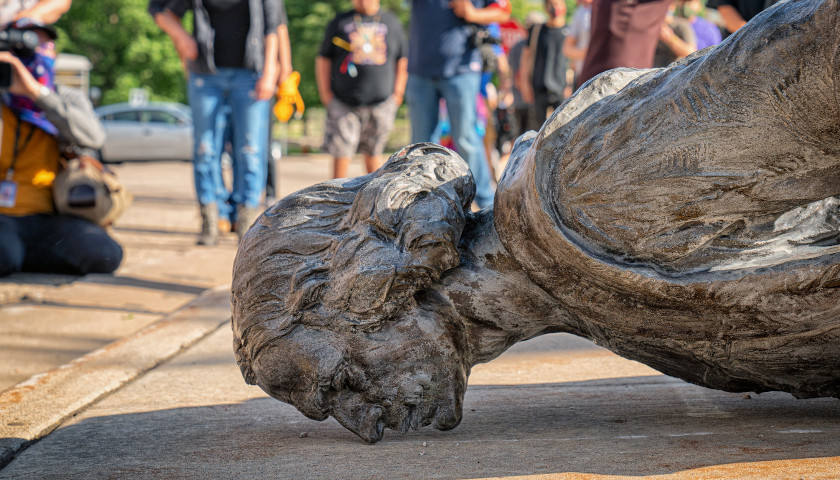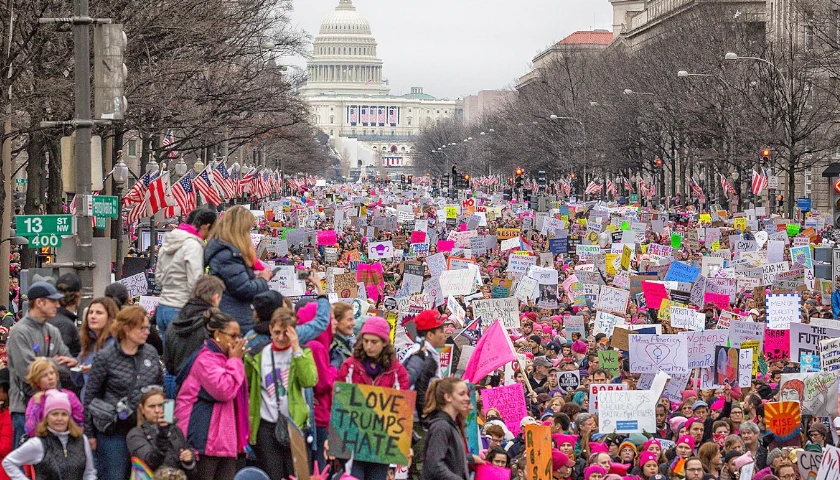by Christopher Roach
Protests and looting were supplanted last week by an orgy of more symbolic destruction. Statues of various figures from our civilization’s past—Christopher Columbus, a Texas Ranger, numerous confederate Civil War memorials, and even Philadelphia’s Frank Rizzo—have been toppled, defaced, or scheduled for removal by compliant officials.
In the same spirit, a Senate GOP committee recently voted to rename military bases named after confederate generals. Those names—Fort Bragg and Fort Hood, among them—have acquired their own connotations as centers of excellence, but must be renamed because their long-forgotten namesakes fought on the losing side of the Civil War.
The focus on southern war memorials is simply pretextual. No one is calling for a restoration of the confederacy. Rather, a war on confederate symbols is part of a broader, large-scale revision of our history, where the nation’s past is rewritten as a story of “systemic racism,” and thus, anything honoring an old, dead white guy is in jeopardy.
Related protests in the UK have targeted Winston Churchill, for example. Ludicrously, rioters desecrated a statue of abolitionist Matthias Baldwin in Philadelphia. An Alabama professor even floated plans to topple the Washington Monument itself.
The Destruction Is the Message
Just as statues are symbolic, their destruction is also symbolic. Destruction reimagines the statues as defeated enemies. In such acts, those whom they symbolize are also deemed worthy of destruction.
Dehumanization, after all, is widely considered to be one of the important preconditions of genocide. That is, destroying the art and symbols of a people is a step along the road to destroying the people themselves. Who can forget the crude and callous imagery of Jewish headstones used as pavers for a road in Schindler’s List?
In an interview on recent events, art historian Erin Thompson observed, “Throughout history, destroying an image has been felt as attacking the person represented in that image. Which we know because when people attack statues, they attack the parts that would be vulnerable on a human being.”
After a week of violent riots, one must wonder, “How far does this go? And when does it stop?” Our nation spends over $700 billion on defense, but our country and its patrimony are being mistreated as if we were occupied by a conquering foe. Our cities are being destroyed, our wealth is being targeted for reparations, our ancestors are dishonored, and our dead are denied rest.
There is something particularly repulsive about the destruction of what is first and foremost a work of art. As a student, I remember being revolted by the photographs of defaced classical statues in history books. I knew this vandalism reportedly was committed by the early Christians through an excess of piety. But, whatever the motivation, it also was a permanent and irreversible crime against aesthetics.
A statue is a work of art with a very unique quality. In their lifelike subtlety rendered in marble or bronze, statues also suggest permanency and an idealized humanity. The depiction of a particular person in a sculpture can portray transcendent ideals that rise above the particular subject in a way neither painting or photography can capture.
People are not perfect, not in the past and certainly not now. But the lofty and enduring qualities rendered in our public art are the qualities that can make us more perfect and more human. Our nation, which was built on high ideals, has particularly honored those qualities required to sustain successful self-government: George Washington’s public spiritedness and leadership, Jefferson’s reason and idealism, and Lincoln’s moral vision of freedom for all men.
This pantheon of heroes unified a young nation not bound primarily by common ancestry, but rather through a celebration of those virtues conducive to good citizenship. No one ever pretended that a statue meant the actual subject was flawless. But the statues destroyed this week each depicted qualities we should admire, including the Faustian spirit of Columbus crossing the ocean, the moral courage of Matthias Baldwin, or the tragic physical courage of the confederate soldier. Destruction and vandalism show contempt for those qualities and disregard for the rights of one’s fellow citizens to make up their own minds about these symbols and the nation’s past.
Unmasking the Virtues of Republican Self-Government
The new revolutionary order, born during the 1960s and continuing through to the present, finds its most authentic expression in the practice of unmasking. The nation’s legacy history withers under this endless critique, which picks at every scab and exposes every flaw. The greatness of George Washington is forgotten; instead, we remember inane trivialities, such as that he had wooden teeth (although he didn’t).
The cultural revolutionaries find not only the nation, but the whole concept of an elevated humanity to be a myth that must be unmasked and discarded. This had much to do with the explosion of scatological and sexual foul language during the counterculture revolution of the 1960s. Such language is now so commonplace as to be unremarkable, but the reason it was criticized initially is because it reduces our humanity to the lowest of bodily functions, just as unmasking history reduces our national story to nothing but a long list of offenses.
There are many regrets and injustices to be found in every nation, and every individual. But these demerits are no less true of other institutions we take pride in, such as our Church, our alma maters, or our families.
Are these flaws the essence of the story? Does this reduction of American history to a ghost story about white villainy inspire patriotism or facilitate racial peace and harmony today? Doesn’t it, to the contrary, demoralize the majority while flattering the minority, encouraging the descendants of erstwhile victims to cultivate a blood vendetta, while offering no mechanism for reconciliation?
The modern-day barbarians may not know the details surrounding the things they have destroyed, but they know full well what they’re doing. It is all a huge flex. Language, flags, heroes, and symbols—as well as the forcible changing of these things—express who is in charge and what the nation stands for.
Domestic and foreign policy are all part of politics. But, before policy, there is the foundational question of political life: Who are we? What does our society honor? Today, every instrument of elite power honors George Floyd as an idealized victim. He is more elevated than the heroic George Washington or, for that matter, the brilliant George Washington Carver. A cult of victimhood and revenge flows directly from that earlier unmasking of the nation’s heroes and idealistic sense of itself.
Destroying symbols of America’s past says that the people who built the country, wrote its laws, and fought its wars have no particular claim to ownership or control over the nation’s land or its future. The unmaskers label the nation’s erstwhile ideals—reason, law, heroism, and chivalry—as fraudulent, a mask for a corrupt core. They aim to replace these ideals with their opposites: emotion, lawbreaking, victimhood, and limitless revenge.
This frenzy of destruction is not about marble and bronze. It is, rather, a symbolic expression much like the statues themselves. And the message is that the people and ideals depicted in these statues must give way before an uncompromising political program of abolition—not of slavery, long since abolished—but of the American people themselves, along with the nation they built.
– – –
Christopher Roach is an attorney in private practice based in Florida. He is a double graduate of the University of Chicago and has previously been published by The Federalist, Takimag, The Journal of Property Rights in Transition, the Washington Legal Foundation, the Marine Corps Gazette, and the Orlando Sentinel. The views presented are solely his own.
Photo “Christopher Colombus Statue Removal” by Tony Webster. CC BY 2.0.





